Recent Posts
-
Real Crimes and the Coming Violence
September 6, 2025
-
Whither Modern Life?
June 27, 2025
-
What the Hell
June 18, 2025
-
As Darkness Engulfs Us
April 6, 2025
-
AI, Risk, and Work
January 17, 2025
-
“Things Are in the Saddle, and Ride Mankind”
December 29, 2024
-
Forgotten Futures in Seattle
December 12, 2024
-
Autocracy Defeats Neoliberalism
November 14, 2024
-
History… We’re Soaking in It!
October 2, 2024
-
A Numbing Spectacle
September 22, 2024
|
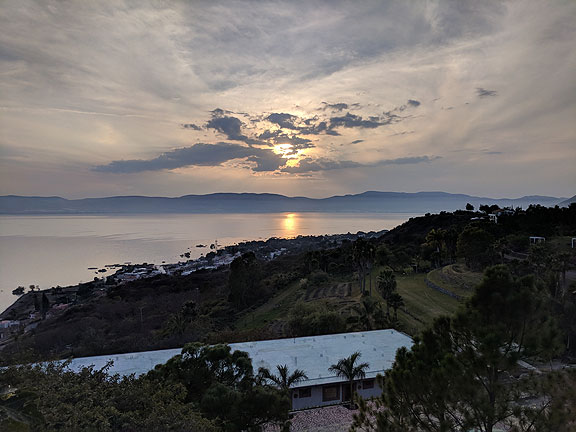 Sunset over Lake Chapala from Monte Cosala, New Year’s Eve, 2017. It’s 2018. The next big war is on the horizon, though how it will begin and against whom is entirely unclear since the government is a thrashing incoherent mess. Meanwhile the U.S. is already in dozens of wars across the world, with hostilities, death, bombing, and mayhem occurring in more places than most Americans could find on a map… the old dictum to learn geography through bombing isn’t even holding up anymore…
The strange disconnect between a society and its imperial misadventures says more about the oblivious psychology of most Americans than it does about the actual effects because those are quite real. The tens of thousands of desperately poor people huddled in doorways and in vacant lots, hoping for a miracle, are the necessary and inevitable complement to the barbarism that leaves a tiny few with the wealth of billions while the U.S. government pisses billions more away every month to instill global terror under the Orwellian banner of fighting terrorism! Anyone with a heart and brain is deeply ashamed of U.S. society these days.
The hysterical hand-wringing about Trump and his venal minions is used to push all “resistance” towards voting for Democrats in the Fall—yes, the Democrats. The same ones who last week were yelling about Russia and racism while voting to maintain unlimited warrantless NSA surveillance under the control of that most trustworthy leader, Trump. We have a government of millionaires, by and for millionaires, and yet a stunning number of people still think voting in a batch of fresh-faced Democrats is going to alter our trajectory. It’s enough to start looking at long-term escape from this asylum.
 American white pelicans winter on Lake Chapala… mostly on the southern shore, far from where we stay… 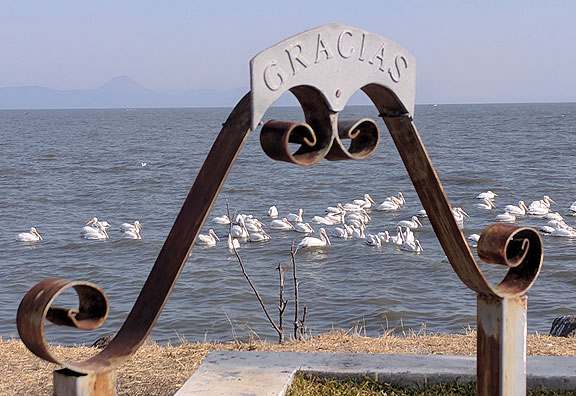 In Petetan, where they feed the pelicans every morning at dawn. But all of this isolated fretting is so typical of this era, sitting alone watching cable news or the social media feed on a phone. We are living in a world that is profoundly lonely. Even I feel that way, in spite of having dozens of friends, and a fairly vibrant network of smart, engaged, artistic and political friends. There is a self-imposed isolation that is increasingly the easy “choice”–in the face of the social trauma and political psychoses that masquerade as our democratic society it seems perfectly reasonable to pull back, to ratchet down how much attention I give it all. And that in turn feeds a sense of sad and desperate isolation that becomes more insurmountable the longer this dynamic goes on. Knowing that the Trumpist plutocratic agenda is to destroy all forms of social resistance and leave everyone more isolated and full of self-doubt simply underscores the self-awareness of this predicament.
I admit I’ve been reading a lot of things lately that have made it hard to feel optimistic. In Sierra Magazine, where editor Jason Mark has taken a dull monthly and given it some real editorial life, I read an excerpt from Naomi Klein’s recent book “No is not Enough”–and while I appreciate the sentiment, her account of the death of more than half the Australian Great Barrier Reef was heartbreaking in its finality. I saw an article over the holidays in the Guardian about how the boom in fracking and all the new natural gas had lowered the raw material cost for most plastic products by 2/3. So in this decade, from 2010-2020 we have already produced more plastic than in the entire 20th century. Investment is pouring in to take advantage of the newly cheapened feedstocks and $185 billion in new plant was expected to increase plastic production by over 50%. Hey, just what we need! Ocean-clogging microplastics, which is where the used plastic all ends up, are already disrupting food chains in the oceans. Few fish or birds are without plastic debris in their bellies. In just an hour of garbage pickup along Lake Chapala during our holiday we filled more than 9 large trash bags with plastic debris from that gorgeous Mexican freshwater lake full of herons, egrets, cormorants, and pelicans. Every beach in the world is full of plastic crap. The idea that producers see a big profit in producing 50% more than we’ve ever produced, when we clearly already need to radically reduce its use is just one glaring symptom of a world gone totally mad.
Continue reading The Age of Abundant (Plastic) and the Age of Loneliness
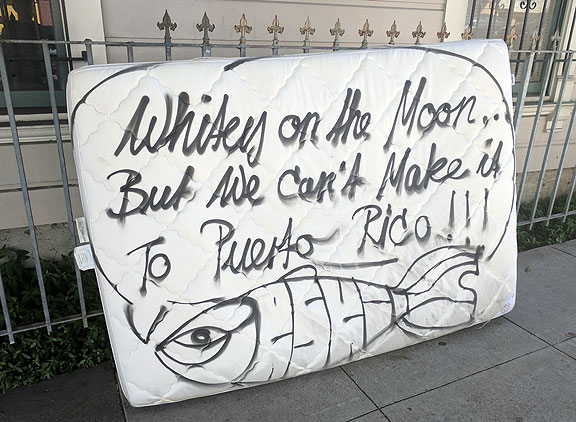 From one of my daily walks across San Francisco, a couple of days after Hurricane Maria had devastated Puerto Rico… months later the story has not improved much.
It’s Thanksgiving 2017 and I’m still here. Haven’t blogged since mid-summer, primarily because I’ve been writing a new Shaping San Francisco guide book to San Francisco that will hopefully come out next autumn with City Lights Books (and maybe Pluto Press too). I’ve also been teaching a class on “Work and the City” at USF to a delightful half dozen grad students who have hungrily devoured the reading and come in every week ready for an interesting discussion (quite a new experience compared to previous teaching gigs). The weekly excursion through labor history and the contemporary politics of work, economy, and urban life has been refreshing for me, reconnecting me with decades of my own passions and long intellectual work (yes, I had them read, among many other things, various Processed World articles as well as the first few chapters of Nowtopia!).
Our weekly classes have provoked a lot of thought for me, as have the ongoing Public Talks at Shaping San Francisco, as well as the half dozen tours and lectures I’ve given this past few months. Trying to make sense of this strange time in history is not easy. The harsh dystopic reality of the Trump administration’s bulldozing approach to facts, compassion, and common sense is a daily affront. But it’s all too easy to fall prey to the Distraction Machine that got us here in the first place, and to lose the ability to look at the bigger picture. Whatever the frantic machinations of the venal kleptocrats around Trump, or the self-serving millionaires who sit in the Congressional majority, there are deeper changes afoot. These changes are global in nature, not limited to the U.S. and its endless self-importance, a national narcissism that grows ever more consuming as the actual power of the country and the culture tips into permanent and inevitable decline.
As I like to do with this blog, I’m going to talk about four books I recently read that complement each other quite well, and offer some compelling insights into this elusive bigger picture. The different authors have different purposes in their works, so they don’t necessarily line up tidily into one discussion, but their overlaps are part of what made me want to finish them before finally taking up this blog again. From darkly pessimistic to perhaps overly hopeful, taken together I think they help frame some of the questions we should be looking at beyond the ebb and flow of daily scandals and predictable barbarisms. The four books are Ellen Ullman’s Life in Code (and I should say that she spoke at our Talks series in October and you can check it out here); Franco ‘Bifo’ Berardi’s Futurability: The Age of Impotence and the Horizon of Possibility; Zeynep Tufekci’s Twitter and Tear Gas: The Power and Fragility of Networked Protest; and the latest from Michael Hardt and Toni Negri, Assembly.
 Clearly Clearly 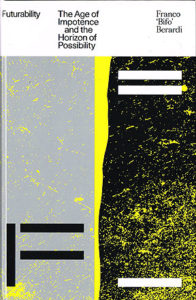 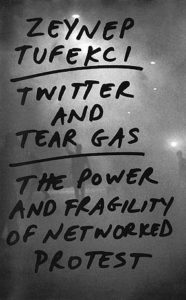 we are on the edge of something new and different, culturally and economically. Nearly everyone is in a state of worried waiting, anticipating various outcomes with their eyes firmly set on the rear-view mirror—are we going to become a full-blown fascist dictatorship? Will we turn away from authoritarian buffoonery and embrace a new New Deal? What else can we imagine going forward, especially given the rapidly changing methods we collectively use globally to produce the basics of life? Will robots and Artificial Intelligence combine to become our new Overlords or will we wrest control of technology and begin radically changing how we work and what we do? And what about the collapse of the planetary ecosphere? Is that now inevitable or can we still avert complete catastrophe through clever adaptation and vigorous reorganization and repurposing of our daily activities? Obviously a lot of these problems are connected! we are on the edge of something new and different, culturally and economically. Nearly everyone is in a state of worried waiting, anticipating various outcomes with their eyes firmly set on the rear-view mirror—are we going to become a full-blown fascist dictatorship? Will we turn away from authoritarian buffoonery and embrace a new New Deal? What else can we imagine going forward, especially given the rapidly changing methods we collectively use globally to produce the basics of life? Will robots and Artificial Intelligence combine to become our new Overlords or will we wrest control of technology and begin radically changing how we work and what we do? And what about the collapse of the planetary ecosphere? Is that now inevitable or can we still avert complete catastrophe through clever adaptation and vigorous reorganization and repurposing of our daily activities? Obviously a lot of these problems are connected!
In Assembly Hardt and Negri cite Carlo Vercellone for extending Marx’s periodization to
the cusp of the twenty-first century, when capital’s center of gravity shifts from large-scale industry to the phase of “general intellect,” that is, production based in increasingly intense and widespread circuits of social cooperation as well as machinic algorhithms as the basis to extract value from the production and reproduction of social life, a phase in which the distinction between the economic and the social is becoming increasingly blurred. (p. 41)
Similarly, Bifo is also rooted in a Marxist sensibility that sees our current era as defined fundamentally by the possibility of transcending the capitalist control of time and space: “The possibility of emancipation of social time from the obligation of salaried work still exists: it is located in the cooperative knowledge of millions of cognitive workers,” (p. 21) but unlike Hardt and Negri’s relative optimism, Bifo has written his book to analyze the blockages and limits that are preventing the cohort of “cognitive workers” from moving forcefully towards self-emancipation. “They are cooperatively running the process of innovation, invention and implementation of knowledge, but they do not know each other. The cooperating brains have no collective body and the private bodies have no collective brain.” (p. 51)
Bifo’s Futurability whipsaws back and forth between his conviction that no social subject exists at this time with the self-consciousness or political agency to pursue emancipation, and his invocation of the possibilities we face:
it is a tendency towards full deployment of the general intellect, the possibility of an emancipation of technology from the semiotic context of capitalism, the liberation of time from salaried work, the revitalization of collective life, and the expansion of care, cultural education and research: a post-labourist future. … The task of free thought is to enable freedom, and freedom means autonomy from the blackmail of realism that forgets the inscribed possibility and only sees the forms of power currently deployed. (p 64)
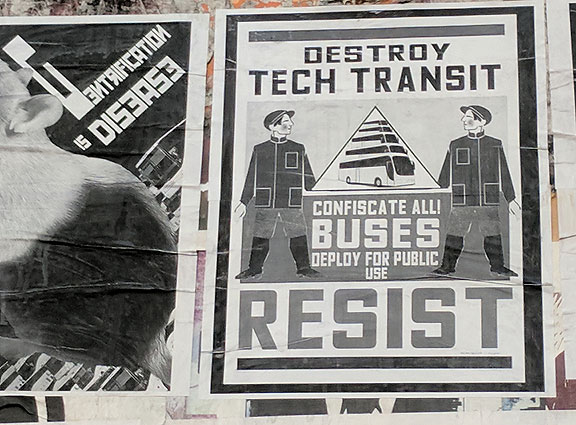 Photographed on Democracy Wall on Valencia Street in San Francisco… Continue reading Uniting Cognitarians is like Herding Cats!
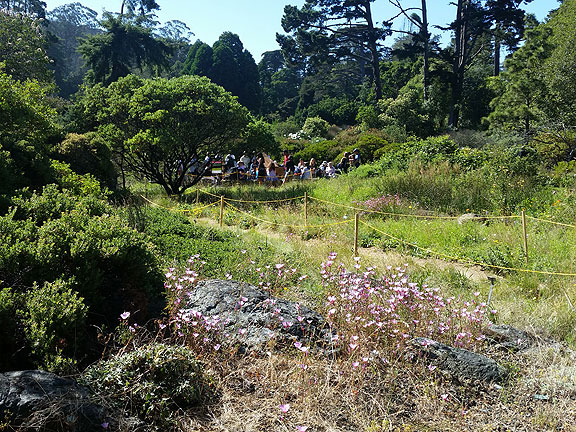 The amazing free public Flower Piano takes place in the San Francisco Botanical Garden over two weekends in July… over a dozen pianos set in gorgeous spots with an endless stream of talented pianists either scheduled, or dropping in to play for fun. On Sunday July 16, the weather was spectacular, the crowds were plentiful but not overwhelming, and the hours passed blissfully in one ideal spot after another… Here is the California native plant garden with a piano in the distance, surrounded by enthusiastic listeners. It’s a beautiful summer in San Francisco. I’ve obviously not been keeping up my blogging. We’re living in strange times to be sure, and I, like most people, am intermittently obsessed and disgusted by the ongoing trauma of what passes for a federal government these days. Not that I would’ve felt much better with another round of Clintonism, but this endless narcissism and inarticulate stupidity distracting attention from the profoundly venal and kleptocratic seizure of public wealth is a tough diet to stomach. And our collective responses have been pretty feeble, after an encouraging first few weeks, having descended into predictable patterns of “clicktivism” and frenzied, panicky “activistism,” neither of which does anything but reassure the practitioner that they are “doing something” (no matter how impotent). I’m not saying this from a position of having the correct line, or the appropriate program, or even better behavior. I’m busy writing one book, contributing to another, carrying out a summer full of research for yet another project, and as always, preparing an interesting line-up for our Fall Shaping San Francisco Talks and Tours. I’m also organizing a syllabus for a new class on labor history and politics that I’ll be teaching this fall at USF, the first time I’ve been able to design a class on this topic that’s been so central to my life, so I am very excited about this! So I’m busy. I also realize that most of our political efforts are hollow at best, whether directed locally, state-wide, nationally, or globally.
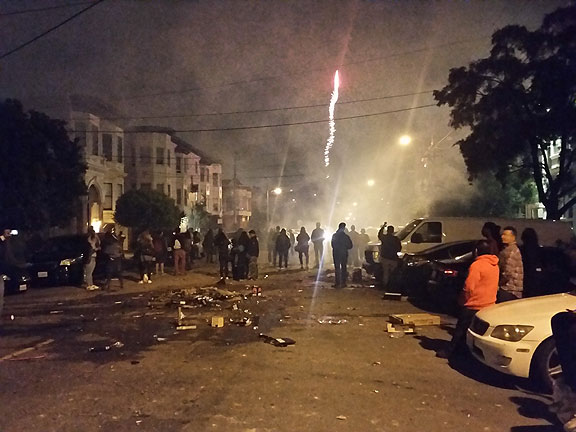 Premonition of Civil War to come? Nah… just a routine 4th of July on Harrison Street a block from my home… This doesn’t mean I don’t believe it’s possible to radically change the world, to radically change how we live. Our political efforts fall short because we don’t address the heart of our predicament. For a long time I tended to explain this by saying “wage-labor” was the heart of the problem. I still think so, but obviously that doesn’t get you too far in this culture. Lately I’ve taken to framing the question as “how do we make life? How do we produce the world we want to live in?” I want to engage and stimulate the subjective capacity of each individual to rethink their own behavior, but also to reconnect to the collective process by which we make life together. Because even if we live in a neoliberal fantasy that our personal choices make our lives, and that all problems are solvable by changing those choices (like whether or not to have health insurance?!?) in a context-less, permanent present, the reality is that our collective and cooperative social production of life is dominated by interests and powers that ensure they are the winners and most of us are the losers. The enormous concentration of wealth in San Francisco and the Bay Area has as its inevitable and necessary companion the enormous rise of homelessness and desperate poverty, conditions that threaten to grow dramatically worse if the current regime’s agenda is carried out. Even if we just manage to hold it at bay, the polarization will continue to gain speed, and the expansion of poverty will continue while the 1-10% at the top keep getting richer and more clueless.
Where does that leave us? Should we be signing more petitions? Writing more letters to corrupt millionaires who masquerade as our political representatives? Continuing to post articles on Facebook proving our point of view about politicians, generals, corporations and their CEOs is true? It seems that with all the imaginary power to communicate we’ve gained from social media, what has really happened is a radical increase in our isolation and social impotence. We feel connected through our phones and screens, but that connection amounts to nothing when it comes to the trajectory of society. I’m not alone in feeling this, and like many I’m coming ever closer to checking out of the social media house of mirrors.
Organizing, going door to door, making real relationships among neighbors, coworkers, people who live and work near each other on an ongoing basis, is the indispensable missing link. I assume lots of newly activated people are doing this in various parts of the country. I have heard anecdotally that a lot of old friends have decided to join DSA (Democratic Socialists of America) because that group is the closest to the Bernie Sanders-style politics that suddenly legitimized a type of left-wing democratic socialism, and they are committed to grassroots organizing… I haven’t felt the same calling, but I respect those who have. I do share the frustration with the circular firing squad logic of young radicals, who continue to attack anyone who fails to embrace every nuance and detail of what today’s recipe for “real revolution” entails.
I was talking to a friend a couple of days ago in a café about our having spent too many years being pure, being so sure of our own revolutionary beliefs that we had a hard time relating to anyone who didn’t share the same ideas, and that we were both sick of that. We’re at least smart enough to look around and realize that whatever certainty we held had no effect on a larger social movement (as we imagined it might at various points going back as far as the 1970s), and that actually the kind of social movements we thought of ourselves as the far left-wing of had withered away and died, much as we’d always hoped the state would! Whoops!
Continue reading Life is Great! Life is Horrible!… OK, It’s Both!
|
Hidden San Francisco 2nd EDITION!

NEW 2nd EDITION NOW AVAILABLE!
Buy one here
(Pluto Press, Spring 2025)
|





 Clearly
Clearly

 we are on the edge of something new and different, culturally and economically. Nearly everyone is in a state of worried waiting, anticipating various outcomes with their eyes firmly set on the rear-view mirror—are we going to become a full-blown fascist dictatorship? Will we turn away from authoritarian buffoonery and embrace a new New Deal? What else can we imagine going forward, especially given the rapidly changing methods we collectively use globally to produce the basics of life? Will robots and Artificial Intelligence combine to become our new Overlords or will we wrest control of technology and begin radically changing how we work and what we do? And what about the collapse of the planetary ecosphere? Is that now inevitable or can we still avert complete catastrophe through clever adaptation and vigorous reorganization and repurposing of our daily activities? Obviously a lot of these problems are connected!
we are on the edge of something new and different, culturally and economically. Nearly everyone is in a state of worried waiting, anticipating various outcomes with their eyes firmly set on the rear-view mirror—are we going to become a full-blown fascist dictatorship? Will we turn away from authoritarian buffoonery and embrace a new New Deal? What else can we imagine going forward, especially given the rapidly changing methods we collectively use globally to produce the basics of life? Will robots and Artificial Intelligence combine to become our new Overlords or will we wrest control of technology and begin radically changing how we work and what we do? And what about the collapse of the planetary ecosphere? Is that now inevitable or can we still avert complete catastrophe through clever adaptation and vigorous reorganization and repurposing of our daily activities? Obviously a lot of these problems are connected!












